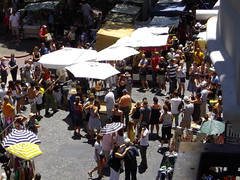Blog Archives
Carnaval!
The number of foreigners exponentially exploded and the streets were overflowing with tourist shirts, cameras and different languages.
The frocks were out and about in the streets at the annual ‘Banda de Ipanema’.
Basically the idea is everyone gets behind a giant truck with speakers and dances around the streets for about 5 hours. It’s a great day out as everyone goes crazy with the costumes and is happy to enjoy themselves for the day.
The street parties or ‘Blocos’ each have a different flavour in the different suburbs around Rio. There’s always something happening somewhere so you can never be bored or sit still in this town during Carnaval!
I don’t know if you have ever seen pictures of the giant Carnaval parade, or Desfiles de Escolas de Sambas in Rio. All I can say is wow! Danny, Aija and I jumped onto a train on Monday night and walked down to the Sambodromo, the purpose-built Samba stadium designed by Oscar Niemeyer.
We had to hang out and look for scalpers on the night as we hadn’t bought tickets beforehand. Eventually we came across one that we felt might not be ripping us off by much and went to meet a friend of a friend with a suitcase full of tickets. But the uneasy feeling passed when the magnetic strip worked and we made it through the gates.
The parade begins at 9.00pm and usually finishes around 7.00 the next morning. Each group or ‘school’ of samba takes an hour and a quarter to get through and can have up to 8 floats of gigantic proportions and thousands of people in costume to dance and parade. There were 14 samba schools in the main parade over two nights. The floats were amazing, the dancing was intense and the atmosphere was juicy.
On the train ride home all I could think about was all the costume shops in Brazil, bereft of anything glittery or sparkly for the next three months!
Carnaval isn’t just a huge party. The Government in Rio use it to promote community spirit. Communities will decide to pay to set up a school of samba, and then pay to create floats and costumes and write a new song to march to. The Carnaval parade has a number of judges that look at things like harmony and quality of the dancing, the roles of the different people, the floats and a whole host of other aspects.
The winner of the parade gains a large sum of money from the Government to put towards their local community. This year saw the Beija-Flor school of samba win again. They’ve now won three years in a row.



